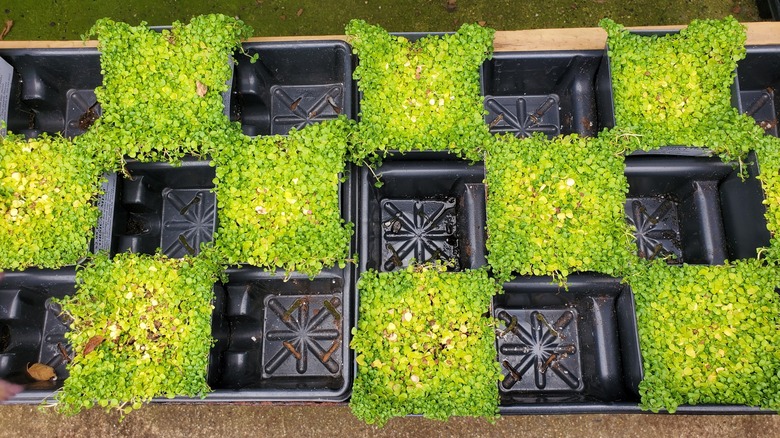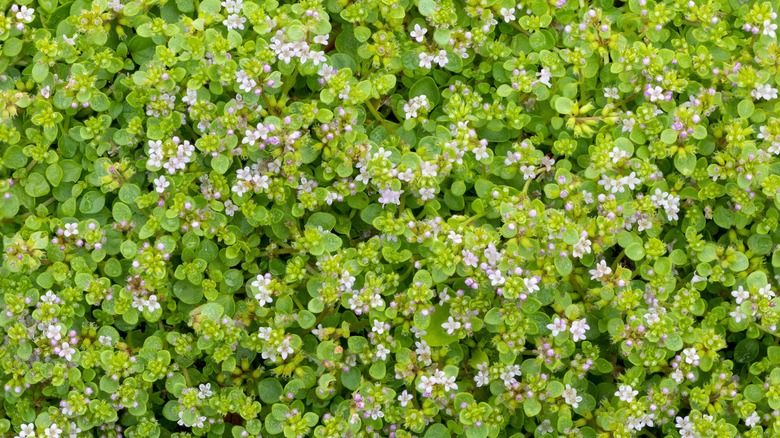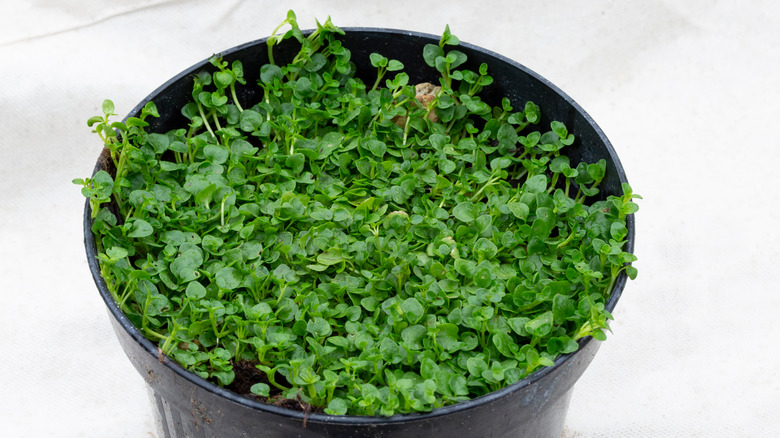Corsican Mint Is A Beautiful, Fragrant Ground Cover, But Is It Worth The Effort?
Teeny violet-like flowers erupt from a lime-green sea of button-cute leaves. If this vision doesn't convince you of Corsican mint's appeal, one step onto a path covered with the creeper likely will. The smell that enters your nostrils is one of curling up with a good book and a steaming mug of fresh mint tea on a chilly Sunday afternoon. However, the plant isn't all cozy vibes and sweetness; it outcompetes native plants in some places. Should you grow it? The simple answer is yes. Given the right conditions, the plant forms a lush mat with little input. It's a low-maintenance way to create an eye-catching front lawn or backward rockery. Of course, if you live in a part of the U.S.A. where it may be considered invasive, you might want to think twice.
Corsican mint (Mentha requienii) — also sometimes called creeping mint or rock mint — has been popular in American gardens since at least the 1980s, as a 1985 Research Extension Series publication on ground covers for warm climates attests. The plant is native to the French-Italian islands of Corsica and Sardinia and Tuscan Montecristo and is naturalized in much of Europe and elsewhere. Here in the U.S., it thrives in damp shade in Hardiness Zones 7 to 11 — in colder areas, it dies back in winter. It's an evergreen perennial reaching heights of ½ to 2 inches. Like other mint species, it spreads by rhizomes and stolons, quickly colonizing wherever it's planted.
The great mint debate
Mint family plants are widely considered challenging to control, so you might conclude the same for Corsican mint. However, advice is divided. Some sources declare the plant invasive in the southeast United States, while others are vague. Per the Royal Horticultural Society, it "may have the potential to become a nuisance," and Missouri Botanical Garden appears to confirm that it "can be somewhat invasive but is usually easy to control." On the other hand, an Ask Extension Expert outright states that Mentha requienii is "not invasive" and doesn't need to be contained, while another says you might have a hard time getting rid of it once established. It's true; the plant can be fickle, freezing in harsh climates, or dying in drought. Conversely, the leaves rot if this species gets too wet. Plus, although it's often suggested for lawn replacement, it only tolerates some foot traffic.
Arguably, though, there are a lot more pros than cons. It's the perfect plant for edging pathways and filling gaps between pavers, pathway stones, and crevices in rock gardens. That fresh minty fragrance isn't just a delight for the nose; the plant might repel pests of the exoskeletal kind, brassica-loving insects especially, and mice, rats, and deer disklike it. It's disease-hardy and grows in all soils. Bees and butterflies love the early summer blooms, making it a perfect plant for those wondering how to start a pollinator garden. Oh, and did we mention Corsican mint is pet and kid-safe?
Sourcing and planting Corsican mint
Corsican mint should be divided annually, from late spring through early summer; if you know someone with a patch, ask them for some rooted cuttings. You can also buy pots and seeds of the plant relatively easily and for prices that won't break the bank. If using the plant for culinary purposes, a single potted plant is enough for a family. Mountain Valley Growers sells 3-inch pots of USDA-certified organic Corsican mint for $7.95 each. For those needing to cover a large area, an investment of $70.00 will get you a bulk order of 1,000 Mentha requienii seeds from Seedville USA.
So, ground covers: Do you really need them? This petite plant will have you saying yes! It's recommended for everything from pathways to outdoor miniature railways to fairy gardens for good reason. Corsican mint also works well in container gardens in pots 1 to 3 gallons or larger, or use it as the spiller or edge plant in a "spiller-thriller-filler" arrangement. If you're growing the plant for its intoxicating scent, choose a spot with dappled sun rather than deep shade, though it will thrive in both settings. It likes to stay moist (though not oversaturated) and does great planted under rainwater pipes and hose spigots. If you're worried about Corsican mint taking over your garden, bury a large container and plant it there. Avoid planting it near green belts or water sources, where it could quickly get out of control.



